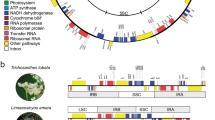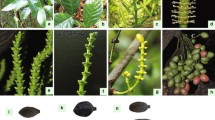Abstract
This study explores methods to use information gathered from genomics technology to understand evolutionary relationships in the hyperdiverse legume group Neo-Astragalus. These species inhabit deserts and mountains of North and South America, and even though the monophyly of the group is well established, relationships within it are still poorly understood. Plastid genes, commonly used to infer phylogenies in plants, are usually not useful for closely related taxa because of low levels of genetic variation. TheMedicago truncatula genome project provided a suite of candidate nuclear loci with high levels of variation that might prove suitable for low-level phylogenetics. This paper reports the development of methods for screening a large number of these nuclear loci, and detailed analysis of four of them. Four different patterns of phylogenetic diversification occur in the loci sampled from these genomes ofAstragalus species. One locus (CNGC4) was single copy and could be directly used in phylogenetic analyses. Two loci (ARG10 and FENR) showed patterns strongly suggestive of duplication events in some taxa, and one locus (tRALS) has apparently undergone a cryptic duplication, making it very difficult to diagnose. Potential methods for using the information provided by these loci are discussed.
Similar content being viewed by others
Literature Cited
Barneby, R. C.. 1964. Atlas of North AmericanAstragalus. Memoirs of The New York Botanical Gardens 13: 1–1188.
Bell, C. J., R. A. Dixon, A. D. Farmer, R. Flores, J. Inman, R. A. Gonzales, M. J. Harrison, N. L. Paiva, A. D. Scott, J. W. Weller &G. D. May. 2001. TheMedicago Genome Initiative: a model legume database. Nucleic Acids Research 29: 114–117.
Bonnin, I., T. Huguet, M. Gherardi, J. M. Prosperi &I. Olivieri. 1996. High level of polymorphism and spatial structure in a selfing plant species,Medicago truncatula (Leguminosae), shown using RAPD markers. American Journal of Botany 83: 843–855.
Britt, A. B. &G. D. May. 2003. Re-engineering plant gene targeting. Trends in Plant Science 8: 90–95.
Brumfield, R. T., P. Beerli, D. A. Nickerson &S. V. Edwards. 2003. The utility of single nucleotide polymorphisms in inferences of population history. Trends in Ecology & Evolution 18: 249–256.
Choi, H. K., D. Kim, T. Uhm, E. Limpens, H. Lim, J. H. Mun, P. Kalo, R. V. Penmetsa, A. Seres, O. Kulikova, B. A. Roe, T. Bisseling, G. B. Kiss &D. R. Cook. 2004. A sequence-based genetic map ofMedicago truncatula and comparison of marker colinearity withM. sativa. Genetics 166: 1463–1502.
Cook, D. R.. 1999.Medicago truncatula—a model in the making. Commentary. Current Opinion in Plant Biology 2: 301–304.
Cunningham, C. W.. 1997. Can three incongruence tests predict when data should be combined? Molecular Biology and Evolution 14: 733–740.
de Queiroz, A., M. J. Donoghue &J. Kim. 1995. Separate versus combined analysis of phylogenetic evidence. Annual Review of Ecology and Systematics 26: 657–681.
Doyle, J. J., J. L. Doyle &J. D. Palmer. 1995. Multiple independent losses of 2 genes and one intron from legume chloroplast genomes. Systematic Botany 20: 272–294.
Felsenstein, J. 1985. Conficience limits on phylogenies—an approach using the bootstrap. Evolution 39: 783–791.
—. 2003. Inferring phylogenies. Sinauer Associates, Inc., Sunderland, Massachusetts.
Ford, V. S. &L. D. Gottlieb. 2003. Reassessment of phylogenetic relationships inClarkia sect.Sympherica. American Journal of Botany 90: 284–292.
Gene-Codes. 1991-2000. Sequencher. Gene Codes Corp., Ann Arbor, Michigan.
Gottlieb, L. D. &V. S. Ford. 1996. Phylogenetic relationships among the sections ofClarkia (Onagraceae) inferred from the nucleotide sequences of PgiC. Systematic Botany 21: 45–62.
Graham, S. W., P. A. Reeves, A. C. Burns &R. G. Olmstead. 2000. Microstructural changes in noncoding chloroplast DNA: interpretation, evolution, and utility of indels and inversions in basal angiosperm phylogenetic inferende. International Journal of Plant Sciences 161 (6 Suppl.): S83-S96.
Graur, D. &W-H Li. 2000. Fundamentals of molecular evolution. Sinauer Associates, Inc., Sunderland, Massachusetts.
Gugerli, F., C. Sperisen, U. Buchler, L. Brunner, S. Brodbeck, J. D. Palmer &Y. L. Qiu. 2001. The evolutionary split of Pinaceae from other conifers: evidence from an intron loss and a multigene phylogeny, Molecular Phylogenetics and Evolution 21: 167–175.
Ingvarsson, P. K., S. Ribstein &D. R. Taylor. 2003. Molecular evolution of insertions and deletion in the chloroplast genome ofSilene. Molecular Biology and Evolution 20: 1737–1740.
Kawakita, A., T. Sota, J. S. Ascher, M. Ito, H. Tanaka &M. Kato. 2003. Evolution and phylogenetic utility of alignment gaps within intron sequences of three nuclear genes in bumble bees (Bombus). Molecular Biology and Evolution 20: 87–92.
Lavin, M., J. J. Doyle &J. D. Palmer. 1990. Evolutionary significance of the loss of the chloroplast-DNA inverted repeat in the Leguminosae subfamily Papilionoideae. Evolution 44: 390–402.
Mathews, S. &M. J. Donoghue. 1999. The root of angiosperm phylogeny inferred from duplicate phytochrome genes. Science 286: 947–950.
—. 2000. Basal angiosperm phylogeny inferred from duplicate phytochromes A and C. International Journal of Plant Sciences 161: S41-S55.
Morin, P. A., G. Luikart &R. K. Wayne. 2004. SNPs in ecology, evolution and conservation. Trends in Ecology & Evolution 19: 208–216.
Nozaki, H., M. Matsuzaki, M. Takahara, O. Misumi, H. Kuroiwa, M. Hasegawa, T. Shin-i, Y. Kohara, N. Ogasawara &T. Kuroiwa. 2003. The phylogenetic position of red algae revealed by multiple nuclear genes from mitochondria-containing eukaryotes and an alternative hypothesis on the origin of plastids. Journal of Molecular Evolution 56: 485–497.
Pons, J., T. G. Barraclough, K. Theodorides, A. Cardoso &A. P. Vogler. 2004. Using exon and intron sequences of the gene Mp20 to resolve basel relationships inCicindela (Coleoptera: Cicindelidae). Systematic Biology 53: 554–570.
Pryer, K. M., H. Schneider, A. R. Smith, R. Cranfill, P. G. Wolf, J. S. Hunt &S. D. Sipes. 2001. Horsetails and ferns are a monophyletic group and the closest living relatives to seed plants. Nature 409: 618–622.
Rambaut, A. 1996. Se−Al sequence alignment editor. University of Oxford, Oxford, UK.
Sanderson, M. J. 1991. Phylogenetic relationships within North AmericanAstragalus L. (Fabaceae). Systematic Botany 16: 414–430.
—. 1993. Phylogenetic-relationships in North-AmericanAstragalus (Fabaceae) based on chloroplast DNA restriction site variation. Systematic Botany 18: 395–408.
—. 1996. Diversification rates in a temperate legume clade: are there “so many species” ofAstragalus (Fabaceae)? American Journal of Botany 83: 1488–1502.
Simmons, M. P. &H. Ochoterena. 2000. Gaps as characters in sequence-based phylogenetic analyses. Systematic Biology 49: 369–381.
——. 2001. Incorporation, relative homoplasy, and effect of gap characters in sequence-based phylogenetic analyses. Systematic Biology 50: 454–462.
Spellenberg, R. 1976. Chromosome-numbers and their cytotaxonomic significance for North-AmericanAstragalus (Fabaceae). Taxon 25: 463–476.
Swofford, D. L. 2001. PAUP*. Phylogenetic analysis using parsimony. Sinauer Associates, Sunderland.
Wojciechowski, M. F., M. J. Sanderson, B. G. Baldwin &M. J. Donoghue. 1993. Monophyly of aneuploidAstragalus (Fabaceae)—Evidence from nuclear ribosomal DNA internal transcribed spacer sequences. American Journal of Botany 80: 711–722.
——. 1999. Evidence on the monophyly ofAstragalus (Fabaceae) and its major subgroups based on nuclear ribosomal DNA ITS and chloroplast DNA trnL intron data. Systematic Botany 24: 409–437.
—. 2004. A phylogeny of legumes (Leguminosae) based on analyses of the plastid matK gene resolves many well-supported subclades within the family. American Journal of Botany 91: 1846–1862.
Author information
Authors and Affiliations
Corresponding author
Rights and permissions
About this article
Cite this article
Scherson, R.A., Choi, HK., Cook, D.R. et al. Phylogenetics of New World Astragalus: Screening of novel nuclear loci for the reconstruction of phylogenies at low taxonomic levels. Brittonia 57, 354–366 (2005). https://doi.org/10.1663/0007-196X(2005)057[0354:PONWAS]2.0.CO;2
Issue Date:
DOI: https://doi.org/10.1663/0007-196X(2005)057[0354:PONWAS]2.0.CO;2




